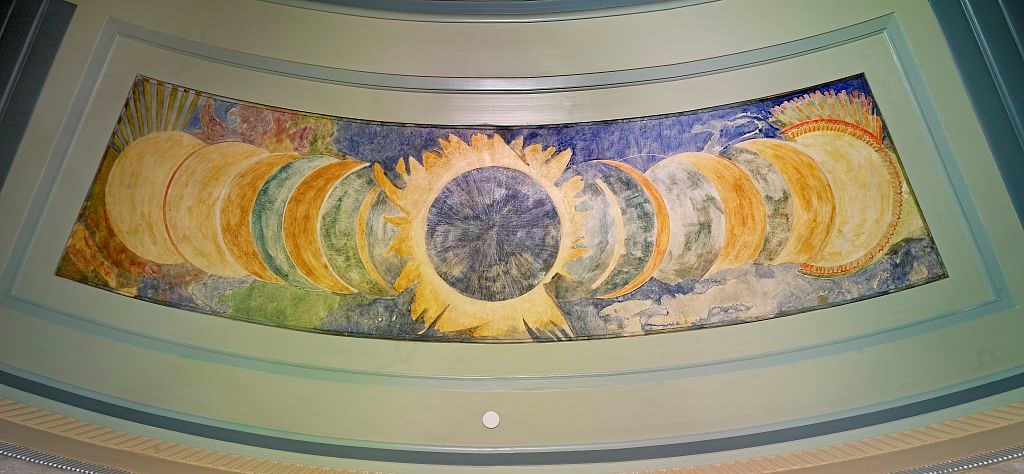Last updated: August 24, 2017
Article
Eclipses in American History

Photo by Carol M. Highsmith, 2007. Courtesy of the Library of Congress.
There are two kinds of eclipses: Lunar and solar. When we see the moon at night, it is because it is reflecting sunlight back to earth. During a lunar eclipse, the earth passes between the moon and the sun, blocking the light of the sun from hitting the moon and being reflected. The moon appears to disappear. During a solar eclipse, the moon passes between the sun and the earth, blocking the light of the sun from hitting the earth. The sun appears to disappear. You can read more about solar and lunar eclipses at NASA.
Some eclipses in American History:
A symbol carved into rock (called a petroglyph) in Chaco Culture National Historical Park may be a representation of a total solar eclipse. The symbol, a filled-in circle with squiggly lines shooting out around its edge, has a small, filled-in circle just to its upper left. Scientists hypothesize that the symbol represents the sun in total eclipse and the small circle is the planet Venus, which would have been seen in that location during the eclipse. This arrangement of celestial bodies took place on July 11, 1097 during the height of Chaco culture.
1758
In 1758, an amateur astronomer in Rhode Island documented the first lunar eclipse recorded by a European colonist. While others had noted celestial events, this astronomer (whose name we do not know) recorded several details.
1805 January 14-15
Lewis and Clark observe a lunar eclipse while at Fort Mandan, North Dakota. Interested in exploring and the natural world, they recorded details of the eclipse, including when it started and ended, in their journals.
1806 June 16
1831 February 12
Nat Turner, an enslaved man in Virginia, often had visions which he interpreted as religious in nature. These visions convinced Turner that he was destined for greatness. In 1831, Turner witnessed a solar eclipse, and took it as a sign. In response, he began preparing for a rebellion against local slaveholders. He purchased muskets and gathered over 70 freed and enslaved men to his cause. On August 22, 1831 they rebelled, killing whites and freeing slaves. By the end of the rebellion, one of the largest slave rebellions in American history, over sixty whites were dead. Militias and law enforcement were called in to put down the rebellion. Over 120 Black people, some of whom had nothing to do with the rebellion, were killed.
1869 August 7
In 1869, Scientist George Davidson, an astronomer and explorer, was exploring in Alaska. He had been in the region two years earlier, surveying before the United States purchased it from Russia. On August 6, he met with the native Chilkat people. The meeting was tense, as the Chilkat were on guard after poor treatment by the American government, and wary. Davidson explained he was there for scientific reasons, in particular to observe a total solar eclipse that his calculations suggested would happen the next day. Uncertain, the Chilkat let Davidson and his party stay.
The next day, the solar eclipse occurred just as Davidson had predicted. While we don’t know what the Chilkat thought of the eclipse or Davidson’s prediction of it, we do know that afterwards, they left Davidson and his party to continue their explorations.
Also in 1869, Harper’s Magazine published photographs of a solar eclipse, perhaps the first example of a mass publication to do so.
1878 July 29
In 1878, a total solar eclipse crossed over Alaska and then passed across the United States from Washington state to the southwest corner of Louisiana. It was an important milestone in American astronomy. Among those viewing the total solar eclipse was Maria Mitchell and an all-woman team of astronomers. Born in 1818, Mitchell trained herself in astronomy. After calculating the orbit of a new comet, she was the first woman elected to the American Academy of Arts and Sciences and became heralded as America’s first woman professional astronomer. In 1865, Mitchell became the first director of Vassar College’s Observatoryand astronomy program.
Thomas Edison was among thousands of people who traveled on the newly built railways to see the eclipse in what was then the “Wild West.” He brought with him equipment to study the Sun’s corona. The eclipse was
1899
In 1889, Mark Twain published his novel, A Connecticut Yankee in King Arthur’s Court. In this work, the hero, a time traveler named Hank Morgan goes back in time to early medieval England. He escapes being burned at the stake by predicting a solar eclipse.
1900
A total solar eclipse brings scientists from around the world to Wadesboro, NC. Learn about this event with the Discover the Solar Eclipse of 1900 in Historic Wadesboro, NC: A Lightning Lesson from Teaching with Historic Places.
1918
The totality of this eclipse was visible from Washington state to Florida. Scientists used this eclipse to test Albert Einstein’s theory of general relativity. Their observations supported his conclusions, and his name became widely known among the public.

From the collections of the Library of Congress.
